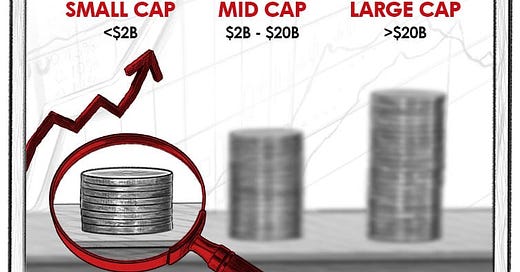NAVIGATING THE OPPORTUNITIES AND RISKS OF SMALL/MICRO CAP INVESTING
Small and micro-cap stocks are often overlooked by investors in favor of more prominent and established companies. However, these lesser-known gems can present unique opportunities for investors with the appetite for higher risk and a long-term perspective. In this article, we will explore the world of small and micro-cap investing, shedding light on the potential rewards and associated risks.
Small-cap stocks typically refer to companies with market capitalizations between $300 million and $2 billion, while micro-cap stocks encompass companies with market caps under $300 million. These companies are considered smaller in size compared to their larger counterparts, which are often classified as mid-cap or large-cap.
The Appeal
Growth Potential: Small and micro-cap stocks have the potential for rapid growth. These companies often operate in niche markets and can experience substantial expansion as they gain market share.
Undervalued Opportunities: Due to their size and lower visibility, small and micro-cap stocks are more likely to be undervalued or overlooked by analysts and institutional investors. This can present opportunities for astute investors to discover hidden gems.
Less Efficiently Priced: Smaller stocks are less efficiently priced than larger ones. This inefficiency can lead to mispricings and provide opportunities for investors who can spot them.
M&A Activity: Small and micro-cap companies are often acquisition targets for larger firms looking to expand or diversify their operations. Investors in these companies may benefit from acquisition premiums.
Diversification: Including small and micro-cap stocks in a diversified portfolio can enhance overall diversification, as they often have low correlations with larger stocks.
The Risks
Volatility: Smaller companies tend to be more volatile than their larger counterparts. This increased price fluctuation can result in significant short-term losses.
Lack of Liquidity: Small and micro-cap stocks often have lower trading volumes, which can lead to liquidity challenges when buying or selling shares, potentially resulting in wider bid-ask spreads.
Limited Resources: Smaller companies may lack the resources and financial stability of larger firms. They may struggle to weather economic downturns or unexpected setbacks.
Transparency: Smaller companies may provide limited information to investors, making it challenging to conduct thorough due diligence and assess their financial health.
Higher Risk of Failure: Smaller companies face a higher risk of business failure. Investors should be prepared for the possibility of losing their entire investment in some cases.
Strategies
Research and Due Diligence: Thoroughly research potential investments. Understand the company's financials, competitive position, management team, and growth prospects.
Diversification: Due to the higher risk associated with small and micro-cap stocks, diversify your investments across a range of companies and industries.
Long-Term Perspective: Approach small/micro cap investing with a long-term horizon. Be prepared to hold your investments through periods of volatility.
Risk Management: Set clear stop-loss limits and risk tolerance levels. Be disciplined in managing your portfolio.
Stay Informed: Continuously monitor your investments and stay informed about developments in the companies you hold.
Investing in small and micro-cap stocks can be a rewarding but challenging endeavor. These companies offer growth potential and opportunities for investors who are willing to conduct thorough research and manage risk effectively. However, it's crucial to be aware of the heightened volatility and risks associated with smaller stocks. Small/micro cap investing should be approached with a long-term perspective and a well-diversified portfolio to mitigate potential downsides while aiming for the potential upsides these often-overlooked companies can offer.
At PP Investment Education, we personally invest our own money mostly in these kinds of companies. We believe they are less researched, not attractive to big investing institutions due to their size, and offer outsized gains if the research is done right. Therefore, we choose them as a place to put some of our money.
You will never hear us talking about opportunities in the largest stocks in the market, such as Tesla, Apple, Microsoft, Netflix, etc. Even though we might believe that some of them are great stocks, we don't think we have an edge in exploring their value, as it seems like everyone is trying to do just that. And why try, when you can get complete exposure to such stocks by buying a cheap ETF that simply follows the S&P 500?
We recognize that this strategy is riskier than conventional ones, but it has worked for us. And if you are someone who can tolerate this kind of risk, you should maybe consider placing some of your portfolio in such a strategy.



